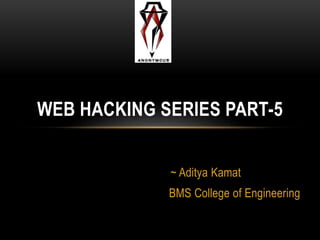
Web Hacking Series Part 5
- 1. ~ Aditya Kamat BMS College of Engineering WEB HACKING SERIES PART-5
- 2. TOPICS LEARNT TILL NOW :- • Basics of web and a little about networks. • HTML injection. • SQL injection to bypass authentication. • Buffer overflow attack. • XSS
- 3. CONT… • Bypass Authentication Via Authentication Token Manipulation. • Session hijacking. • Brute forcing login pages using burp. • HTTP parameter pollution. • SQL injection.
- 4. TOPICS FOR TODAY: • CSRF. • IDOR. • Unrestricted file upload. • We will also have a small competition involving XSS and SQLi at the end.
- 5. CROSS SITE REQUEST FORGERY(CSRF): • It is a type of website exploit carried out by issuing unauthorized commands from a trusted website user. • Unlike XSS, which exploits the users trust for a website, CSRF exploits website’s trust for a particular user’s browser.
- 6. MORE ABOUT CSRF: • It uses the “GET” parameter as the exploit point. • HTML tags are used to inject commands into a specific webpage. • It is a target specific attack, i.e. the commands to be injected usually change for different victims.
- 7. REQUIREMENTS FOR CSRF: • Website should not check for referrer header or a plugin bug which helps in spoofing referrer headers. • The attacker must locate a form to update some content on the target website. • All the values in the form must be correct in order to execute the attack. • The attacker must inject malicious code into the webpage while the victim is logged in to the website.
- 8. DEMO : • Application used: DVWA • Steps to reproduce the POC: • Find out if the request generated is GET or POST. • Find out all the necessary parameters to be passed. • We will be using a sample html page with the same form, with our values for the new password.
- 9. PREVENTION: • Append random challenge tokens to each request. • This token has to be associated with the user session. • Keep a short expiry time for these tokens. References: http://www.cgisecurity.com/csrf-faq.html More techniques: https://www.owasp.org/index.php/CrossSite_Request_Forgery_(CSRF)_Prevention_Cheat_Sheet
- 10. IDOR: • This vulnerability occurs when a reference to an internal implementation object such as files, database key, URLs are exposed to external entities. • Attackers can manipulate or use these references to access unauthorized data. • Open Redirects and Directory Traversal are two classic examples of an insecure direct object reference vulnerability.
- 11. WHAT IS AN OPEN REDIRECT? • This is a feature where the web application has a parameter that allows the website to redirect the user somewhere else. • If this parameter is not implemented properly using a white list, attackers can use this in a phishing attack to lure potential victims to a site of their choosing. • Example: www.example.com/a?goto=example.com/user1 • The parameter passed to “goto” is said to be the redirect URL.
- 12. WHAT IS DIRECTORY TRAVERSAL? • This is a feature which allows for a file present on the server to be rendered by a user. • The web application should be verifying the files being accessed by the user. • If not, an attacker can request other files on the file system and those will also be displayed. • Example: www.example.com/file.jsp?file=report.txt • An attacker can pass the file which has to be read as a parameter to “file”.
- 13. DEMO: • Application used: Mutillidae • Steps to reproduce the POC: • Find the point leaking file information/ URLs • Try modifying the HTTP headers to obtain other possible information. • Search for database config files to obtain database login credentials.
- 14. PREVENTION: • Use only one user or session for indirect object references. • Do not allow object references to untrusted sources. • In the directory traversal example, determine what files the user should access and only grant them privileges to those files. • If direct objects must be used, then the developers should ensure thorough validation that the user is authorized to view what they are attempting to access.
- 15. References for IDOR • https://www.owasp.org/index.php/Top_10_2013-A4- Insecure_Direct_Object_References • http://www.tutorialspoint.com/security_testing/insecure_ direct_object_reference.htm • http://bretthard.in/post/insecure-direct-object-reference
- 16. UNRESTRICTED FILE UPLOAD • Many web application may ask a user to upload his/her photo or documents of some kind. • An attacker can take advantage of this and try uploading a shell. • The developer needs to carefully validate the type of file being uploaded by the user.
- 17. DEMO: • Application used: bWAPP • Steps to reproduce POC: • Search for a file upload page. • Try uploading a php shell on the site. • If the website is validating the extension, try uploading it as phP or php3 etc. • Also try .php.jpeg or .php.png • Use exif tool to add the shell as a comment in the image.
- 18. SOME ADVANCE BYPASS TECHNIQUES: • http://hackers2devnull.blogspot.in/2013/05/how-to- shell-server-via-image-upload.html • https://www.idontplaydarts.com/2012/06/encoding-web- shells-in-png-idat-chunks/ • http://securityidiots.com/Web-Pentest/hacking-website- by-shell-uploading.html
- 20. THANK YOU